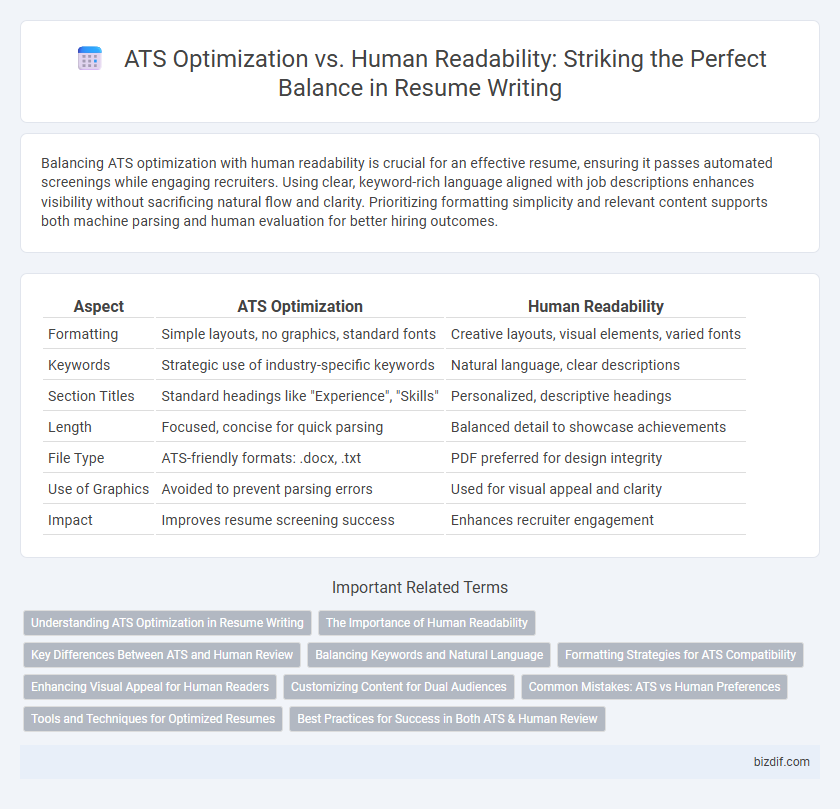Balancing ATS optimization with human readability is crucial for an effective resume, ensuring it passes automated screenings while engaging recruiters. Using clear, keyword-rich language aligned with job descriptions enhances visibility without sacrificing natural flow and clarity. Prioritizing formatting simplicity and relevant content supports both machine parsing and human evaluation for better hiring outcomes.
Table of Comparison
| Aspect | ATS Optimization | Human Readability |
|---|---|---|
| Formatting | Simple layouts, no graphics, standard fonts | Creative layouts, visual elements, varied fonts |
| Keywords | Strategic use of industry-specific keywords | Natural language, clear descriptions |
| Section Titles | Standard headings like "Experience", "Skills" | Personalized, descriptive headings |
| Length | Focused, concise for quick parsing | Balanced detail to showcase achievements |
| File Type | ATS-friendly formats: .docx, .txt | PDF preferred for design integrity |
| Use of Graphics | Avoided to prevent parsing errors | Used for visual appeal and clarity |
| Impact | Improves resume screening success | Enhances recruiter engagement |
Understanding ATS Optimization in Resume Writing
ATS optimization in resume writing focuses on incorporating relevant keywords, proper formatting, and standard headings to ensure the applicant tracking system accurately parses and ranks the resume. Balancing keyword density with clear, concise language enhances both machine readability and human comprehension. Effective ATS optimization improves the chances of passing automated filters while maintaining a professional and easily scannable document for hiring managers.
The Importance of Human Readability
Human readability remains crucial in resume writing because recruiters spend only seconds scanning each document, requiring clear formatting and concise language to quickly assess qualifications. While ATS optimization ensures keywords trigger automated filters, a resume must engage human readers with coherent structure and relevant content to secure interviews. Balancing ATS-friendly elements with readability improves overall resume effectiveness and candidate visibility.
Key Differences Between ATS and Human Review
ATS optimization prioritizes keyword matching, standardized formatting, and specific industry jargon to ensure resumes pass automated software filters. Human review emphasizes clarity, storytelling, and personalized achievements that demonstrate candidate fit and personality beyond metrics. Balancing ATS requirements with engaging, concise content improves both automated ranking and recruiter engagement.
Balancing Keywords and Natural Language
Balancing keywords and natural language is essential for effective ATS optimization and human readability in resume writing. Embedding industry-specific keywords naturally within clear, concise sentences helps algorithms identify relevant qualifications without overwhelming recruiters with keyword stuffing. Ensuring fluid readability maintains engagement while satisfying ATS criteria for scanning and ranking resumes accurately.
Formatting Strategies for ATS Compatibility
Effective resume formatting strategies for ATS compatibility include using standard fonts like Arial or Times New Roman, clear headings, and consistent bullet points to enhance readability by automated systems. Avoiding complex tables, graphics, and excessive use of colors ensures parsing accuracy, allowing ATS software to extract critical information such as job titles, skills, and experience effortlessly. Prioritizing simple layouts with keyword-rich content improves both ATS ranking and human recruiter engagement, balancing technology and readability.
Enhancing Visual Appeal for Human Readers
Enhancing visual appeal in resumes improves human readability, increasing the chances of landing an interview despite ATS constraints. Use clean, professional fonts, clear headings, and consistent formatting to ensure key information is easily scannable. Balancing ATS optimization with visually appealing design elements such as bullet points and white space creates a resume that attracts recruiters and passes automated scans.
Customizing Content for Dual Audiences
Customizing resume content for both ATS optimization and human readability requires strategically incorporating relevant keywords while maintaining clear, concise language that highlights key achievements. Balancing keyword density with natural phrasing ensures the resume passes automated screening systems and engages hiring managers effectively. Tailoring each section to address industry-specific terms and measurable outcomes enhances dual audience appeal and increases interview opportunities.
Common Mistakes: ATS vs Human Preferences
Common mistakes in resume writing include overloading keywords solely for ATS optimization, which can reduce human readability and create a robotic tone. Excessive use of graphics or complex formatting may impress human readers but cause ATS parsing errors, leading to missed information. Balancing keyword integration with clear, concise language ensures both ATS compatibility and appeal to hiring managers.
Tools and Techniques for Optimized Resumes
Leveraging keyword analysis tools like Jobscan and Resunate enhances ATS optimization by ensuring resumes match job descriptions precisely, increasing visibility in automated scans. Incorporating a clean, simple format with standard fonts and clear headings balances ATS compatibility with human readability, preventing parsing errors while maintaining professional appeal. Utilizing techniques such as action verbs, quantifiable accomplishments, and tailored summaries ensures resumes resonate both with machine algorithms and hiring managers.
Best Practices for Success in Both ATS & Human Review
Balancing ATS optimization with human readability involves using clear, keyword-rich content that matches job descriptions while maintaining natural language flow for recruiters. Structured formatting, such as standard headings and bullet points, enhances machine parsing without sacrificing visual appeal or clarity for hiring managers. Incorporating relevant industry terms and measurable achievements ensures the resume passes ATS filters and resonates with human reviewers for best success.
ATS optimization vs Human readability Infographic

 bizdif.com
bizdif.com